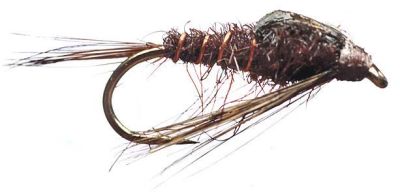 Presented from Issue 106, October 2013
Presented from Issue 106, October 2013
It is time to think nymphs. Numerous trout foods have a nymphal stage as part of their life cycle and these include damselflies, dragonflies, mayflies, stoneflies, caddis and midges. All have different body shapes and colours.
There is no pattern to cover the lot, but I think it is important to get the size and colour correct. The weight depends on what depth the fish are at and as the season progresses the nymphs become larger and more active. Earlier in the season the fish are deeper and as the water warms fish and insects rise in the water column.
You should always have both weighted and unweighted flies in your box. Fishing weighted flies in shallow water will often have you hooked up in debris on the bottom.
Think about all the aspects of depth, current if in a river, or drift if in a boat and choose the weight of your flies to suit. Fly lines and leaders all come into the equation as well.
It is also worth knowing what insects are in the water you are fishing - from large mudeyes (dragonflies) to stick caddis.
I like to keep the patterns relatively simple. One of the most popular nymphs in Tasmania is the mayfly nymph and the pupa - just before it hatches.
One of the best known and popular flies, and very simple to tie Tasmanian nymphs is Dick Wigram’s Pot Scrubber. It has caught thousands of Tasmanian trout. A favourite of mine is a little different, but still easy to tie.
Brown Nymph
Hook: Long shank, medium to heavy weight.
Thread: Brown or black.
Tail: Bunch of fibres from a dark brown cock hackle.
Rib: Medium copper wire.
Body: Dark brown seals fur.
Wing Case: Slip of dark brown turkey feather.
Thorax: Dark brown seals fur.
Beard or Legs: Fibres from a bronze coq de leon feather.
- Method
Take thread full length of hook shank, place tail fibres from a dark brown cock hackle in and tie down firmly.
Place copper wire in and dub in a body of seals fur, shape the body from slim at the tail end to thick at the body end. Finish the body two thirds along the shank. Wind the copper wire over the formed body and tie down firmly. Cut away excess copper wire.
Place the slip of turkey feather on top of the body, tie down, with the main length protruding back towards the tail. This will form the wing case.
Take some more dark brown seals fur and form a thorax slightly larger than the body. This should finish behind the eye — leaving enough room to tie down the wing case.
Pull the turkey slip forward over the thorax, tie down firmly and cut away excess.
Take a bunch of coq de leon feather fibres and tie in underneath the chin of the fly. Cut away excess, whip finish and varnish head. You can also add a couple of coats of varnish on top of the wing case. This adds some strength to the fly and gives a nice sheen.
I like to fish this as part of a team of three nymphs or even some small English wets on lines through from floating through to fast sinking. - Jan Spencer

